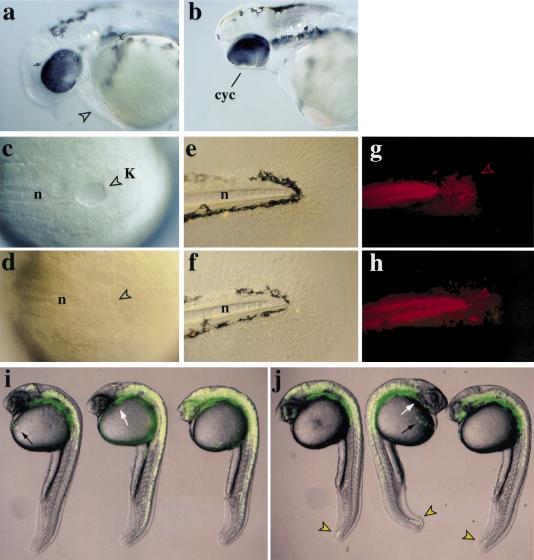Figure 3.
her5 misexpression impairs the formation of the anterior- and posterior-most mesendodermal derivatives. Embryos were injected into a dorsal marginal blastomere at the 16-cell stage with 6 pg of lacZ (a,c,e) or 6 pg of lacZ + 1–3 pg of her5 RNAs (b,d,f) and 2000S rhodamine dextran (anterior to the left). At 36 hr, her5-injected embryos lack hatching gland (arrowhead in a) and display synopthalmia (cyc) (cf. a and b). Embryos were injected into a dorsal marginal blastomere at the 16-cell stage with 6 pg of lacZ (c,e,f) or 6 pg of lacZ + 1–3 pg of her5 RNAs (d,f,h) and 2000S rhodamine dextran, and tail development was observed at 8 somites (c,d) (bright field, dorsal views) or 48 hr (e–h) (bright field and fluorescence views, lateral views; posterior to the right). Kupffer's vesicle (K, arrowheads) (c,d) and forerunner derivatives in the tail fin mesenchyme (g,h, arrowheads) are absent upon her5 expression. The notochord (n) is never affected (cf. c and d, e and f). Embryos were injected in a lateral marginal blastomere at the 16-cell stage with 5 pg of GFP (i) or 5 pg of GFP + 0.5 pg of her5–VP16 (j) RNAs. Composite fluorescent and bright field images are shown. At 24 hr, her5–VP16 has induced the development of forerunner derivatives (j, arrowheads) from the lateral margin, which normally never contributes to this cell population (see i). Other endodermal domains (pharynx, white arrows; hatching gland, black arrows) are unaffected. (hg) hatching gland; (K) Kupffer's vesicle; (n) notochord.

